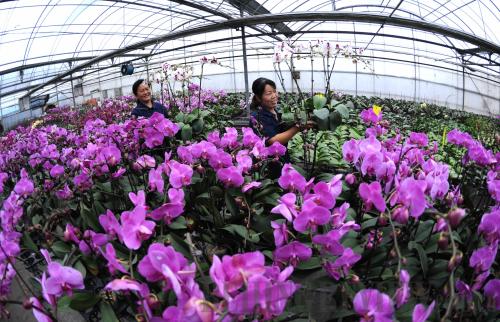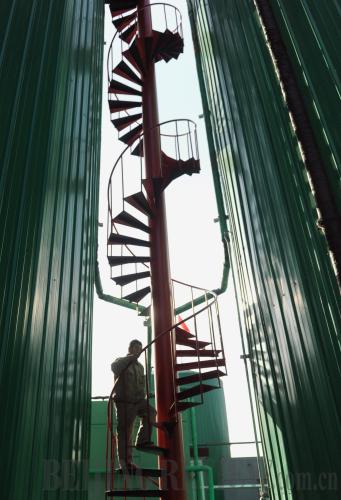|
 |
|
CLEAN ENERGY FOR NATURE'S BEAUTY: Farmers tend to orchids in the Huatai Modern Agriculture Demonstration Park in Tianjin. Terrestrial heat is used to nurture the flowers in the park (LIU HAIFENG) |
Second, China will gradually improve its environmental policies and ensure the market plays a fundamental role in resource allocation. Green credit and pollution responsibility insurance will form binding mechanisms to protect the environment and help the country realize its green economy goals.
Third, China will also take steps to establish a highly efficient and modern industrial system to nurture the green industry. As attention is increasingly placed on environment protection, the environment protection industry has become one of China's prominent sectors and a pillar industry that will lead the green economy's development.
Fourth, China will actively promote green products and speed up the establishment of a consumption pattern conducive to saving resources and protecting the environment. It will focus on improving public awareness and mobilizing all sectors of society to protect the environment.
China has paid a heavy price for its rapid economic growth in the past decades, Wu said, and the current environment problems have become bottlenecks for its sustainable economic and social development. The only way to break these bottlenecks is to create a new path for the green economy with low emissions and sustainable development.
"China will speed up technological innovation to lead this new development of the green economy," said Wang Weizhong, Vice Minister of Science and Technology, at the summit.
Wang said during the 12th Five-Year Plan period (2011-15), China will make breakthroughs in core technologies, strengthen efforts in new energy, information, new materials and biology sectors, and improve its corporate and science innovation capabilities.
Global cooperation
By holding the green industry expo, said Vice Minister of Commerce Jiang Yaoping, the Chinese Government aims to set up three important platforms: a platform for Chinese and foreign companies to exchange and create commercial opportunities; a platform for the Chinese Government to display its resolutions and actions to cope with climate change; and a platform to educate the public about the green efforts.
 |
|
TAPPING NATURAL GAS: The marsh gas project is completed in Changziying Township of Daxing District, Beijing, which produces 920,000 cubic meters of marsh gas every year for 1,650 households in seven villages (XINHUA) |
"The three platforms will play an active role in promoting green and low-carbon production, living and consumption patterns," he said.
China has a good industrial base and a huge market to develop the green economy, Jiang said. Compared with developed countries, China is on par in some sectors, clean energy for example, but lags far behind in other aspects, such as technology, R&D and talent, so the task now is to enhance innovation and international cooperation.
"The Chinese Government will uphold the principle of 'common but differentiated responsibilities,' strengthen international cooperation to tackle climate change and continue to increase support to companies to carry out international exchange," Jiang said.
The Chinese Government also encourages domestic companies to introduce advanced technologies and equipment in the energy-saving, environment protection and low-carbon economy sectors, and will give preferential policies for overseas investment in the green industry, Jiang said. Equally important, China is willing to carry out cooperation with other countries in the energy-saving and environment protection sectors under bilateral frameworks for mutual benefits.
The market prospects of China's green industry have become a magnet for foreign companies looking to invest. At the Green Expo this year, 60 percent of the participants were foreign companies.
Jiang said the Chinese Government will ensure fair competition to foreign companies and grant them equal treatment as Chinese companies.
The Chinese Government has also launched a series of policies and industrial plans on developing the green industry and green economy. Among these, many are about expanding and strengthening international cooperation and where the Chinese Government will uphold the principle of fairness and transparency.
Among the 12,493 international bidding projects for machinery and electric products in 2009, foreign companies bid on 8,863 projects and won 6,887.
Jiang added that as the green economy develops, China will launch more policies to encourage the equal competition between domestic and international companies.
Green Facts (at the end of 2009)
–Small hydropower stations: 55 million kw
–Wind power stations: 25.8 million kw
–Biomass power stations: 4 million kw
–Photovoltaic power stations: 300,000 kw (output of photovoltaic cells surpassed 4,000 megawatts, 40 percent of the world's total)
–Nuclear power: 8.7 million kw
Green Targets for 2020
–Renewable energy consumption will account for 15 percent of China's total; carbon emissions will be reduced to 40-45 percent of 2005 levels.
–Forest coverage will reach 23 percent; forest growing stock will reach 14 billion cubic meters; and forest carbon sinks will be further increased.
–Installed capacity of hydropower generation sets will reach 300 million kw (including 75 million kw in small hydropower stations); wind power 30 million kw; and biomass power 30 million kw.
–The annual utilization volume of marsh gas will reach 44 billion cubic meters and that of ethanol biofuel and bio diesel will reach 12 million tons.
–The total capacity of solar power generation will reach 1.8 million kw, the gross collector area will amount to 300 million square meters and the installed capacity of nuclear power stations will be 70 million kw.
(Source: National Development and Reform Commission) | 